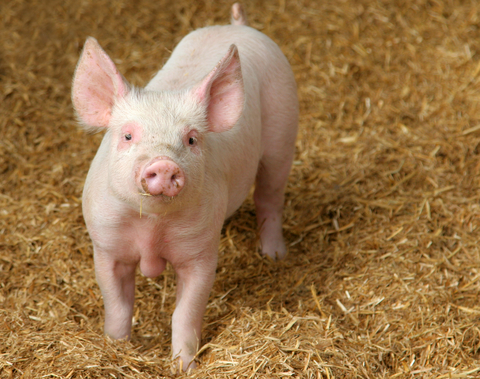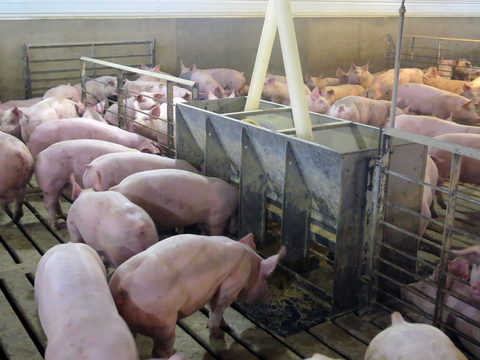

Quick facts
- Growth rate of pigs housed in hoop barns is similar to pigs housed in confinement barns.
- Pigs in hoop barns eat more and are less efficient than pigs kept in confinement barns.
- Feeding a low-energy diet based on small grains slows growth and improves carcass leanness of pigs housed in hoop barns.
- It can cost more to feed pigs fed alternative grains compared to corn-soybean based diets.
Housing pigs in hoop barns
Raising pigs in deep-bedded hoop barns is considered by some commercial markets as animal welfare-friendly. Midwest pork producers have been raising pigs in hoop barns for nearly two decades.
Compared to confinement barns, hoop barns:
- Are less costly to build and operate.
- Require a large amount of bedding.
- Often don’t support pig performance equal to indoor systems.
Hoop-reared pigs fed a traditional corn and soy-based diet eat more and result in fatter carcasses than pigs reared in more conventional housing systems.
Compared to pigs in confinement, pigs raised in hoop barns:
- Wasted slightly more feed.
- Have marginally more last rib backfat.
- Have a lower percent carcass lean.
- Eat more to gain weight in the winter.
Feeding small grains
Small grains are lower in energy and higher in fiber than corn. Feeding small grains may limit fat in finishing pigs raised in hoop barns.
Managing pigs effectively in hoop barns requires a large amount of bedding. Cropping systems that rely on small grains generate both bedding for use in hoop barns and grains for pig feed.
This diversified farming system allows pork and crop production to complement each other.
Studying pig performance in hoop barn systems
Researchers at the West Central Research and Outreach Center conducted a study that looked deeper into swine hoop barn systems.
The study:
- Determined the growth performance and carcass characteristics of finishing pigs fed a diet based on alternative ingredients and housed in hoop barns.
- Determined if dietary changes can reduce fattening in finishing pigs fed in hoop barns.
- Estimated the economic performance of pigs housed in hoop barns compared with environmentally-controlled confinement barns.
|
The study took place at the West Central Research and Outreach Center in Morris, Minnesota. We ran two trials: a winter trial (Dec. 4, 2002 to March 5, 2003) and a summer trial (April 30, 2003 to Aug. 27, 2003).
We used mixed-sex pigs produced by mating Duroc boars to maternal-line sows. We used maternal-line barrows for the summer trial.
We used 848 pigs that had starting weights of 74 pounds.
We assigned the pigs to one of two housing systems: confinement housing or hoop housing.
Confinement housing
We kept confined pigs in a mechanically-ventilated barn. This barn had 8-foot deep anaerobic manure pits under totally slotted, concrete floors. We housed 15 pigs per pen. Each pen was 10 by 15.5 feet, which provided 10 square feet per pig. Each pen had one nipple waterer and one four-hole feeder. We didn’t provide confined pigs drip or spray cooling.
Hoop Housing
The hoop housing system consisted of two 40 by 80-foot hoop barns. We divided each barn lengthwise to create two 20 by 80-foot pens. Each pen housed eighty pigs and provided 19 square feet per pig. Each pen had one 12-hole, round feeder and one four-hole, heated water fountain.
The feeder and water fountain were located on a 20 by 20-foot concrete floor. The sleeping area had a 20 by 60-foot packed clay floor bedded with wheat straw
Results
Common acronyms used throughout the results:
- CCS: pigs raised in the confinement barn and fed a corn-soybean meal diet
- HCS: pigs raised in the hoop barn and fed a corn-soybean meal diet
- HAG: pigs raised in the hoop barn and fed isolysinic diets with alternative grains
We marketed pigs when individual pigs reached about 250 pounds of body weight.
Final body weight at marketing
- HCS pigs weighed an average of 257.2 pounds.
- CCS pigs weighed an average of 255.2 pounds.
Pig market weight varied more for HCS pigs than CCS pigs. This difference occurred even though HCS and CCS pigs had similar amounts of variation in weight at the start of the study.
More uniform weights in CCS pigs may result from a more constant environment provided to the pigs. It could also simply be a result of smaller group size in the confinement barn pens (15 heads per pen) compared to hoop barns (80 head per pen).
We marketed pigs over a period of four weeks to maximize the number of pigs that would achieve our target market weight of 250 pounds. We express performance as the performance for all pigs from the start of the study to the day we first marketed pigs, and performance to the day that we ended the trial.
- Pigs housed in the hoop barns had similar daily weight gains to first marketing as pigs in the confinement barn when fed the CS diets.
- HCS pigs ate about 7 percent more feed than pigs in the confinement barn.
- Efficiency of gain was about 6 percent worse for pigs in the hoop barn compared to the confinement barn.
- HAG pigs had lower daily weight gain and required more feed per unit of gain compared to HCS pigs.
Pigs assigned to diet and housing treatments didn’t face any major health problems. All pigs involved in the study had mortalities of less than 1 percent.
We recorded a total of 24, 40 and 52 pig-treatment days for CCS, HCS and HAG treatments, respectively. A pig-treatment day is any day that a pig required any type of injection or other special health care. The percent of pigs treated in the CCS, HCS, and HAG treatments was 2.85, 5.62 and 7.86, respectively. These differences weren’t statistically significant.
Total labor required to care for pigs in the confinement barn was about 14 minutes per pig. Feeding accounted for about 6 minutes of total labor. In the hoop barns, the care for each pig required 8.5 minutes.
We divided the labor requirements into five categories.
-
Health maintenance: includes treatment of sick or injured pigs.
-
Management of pig comfort: includes bedding pens in hoop barns, cleaning feeders and waterers and adjusting and cleaning fans and heaters.
-
Feeding: includes placing feed in feeders.
-
Recording feed weight required each feeder be filled manually, which increased the labor needs for feeding in this study compared to commercial production systems that use automatic feed delivery systems.
-
-
Daily barn checks.
-
Miscellaneous.
Total straw bedding required per pig placed ranged from 334 pounds for pigs in the winter to 215 pounds for pigs during the summer trial.
Effects on carcass traits
Carcass data was collected on all pigs that achieved the desired market weight (250 pounds) within the four-week marketing window.
Only 62 percent of the HAG pigs had the desired market weight during the marketing period compared with 81 and 80 percent for CCS and HCS pigs, respectively.
The fastest growing pigs (CCS and HCS) dictated the marketing period. So, a comparatively low proportion of the slower growing HAG pigs were ready for market during the marketing period.
A 10-day delay in the marketing period for HAG pigs would have resulted in more HAG pigs reaching the desired market weight.
Effect of housing system and diet on carcass traits of finishing pigs
| Trait | Confinement barn | Hoop barn, corn-soy fed | Hoop barn, alternative grain fed |
|---|---|---|---|
| Number of pens | 14 | 3 | 3 |
| Number of pigs | 171 | 192 | 147 |
| Market weight | 255.2 pounds | 257.2 pounds | 252.6 pounds |
| Hot carcass weight | 187.8 pounds | 189.0 pounds | 182.7 pounds |
| Last rib fat depth | 0.93 inch | 1.02 inches | 0.92 inch |
| Tenth rib fat depth | 0.99 inch | 1.09 inches | 0.99 inch |
| Percent lean | 55.48 percent | 54.42 percent | 55.16 percent |
| Loin eye area | 6.55 square inches | 6.17 square inches | 5.97 square inches |
- HCS pigs were fatter than CCS pigs.
- HCS pigs had increased backfat depth at the tenth and last ribs and lower percent carcass lean than CCS pigs.
- HAG pigs had lower backfat depth and increased percent carcass lean compared to HCS pigs.
It’s hard to determine how much of the improved carcass leanness is due to the lower energy content of the alternative grains and how much relates to the lighter carcasses of HAG pigs at harvest.
We collected 20 loins per group on the same day during the winter trial. Loin meat quality was tested in a laboratory setting. We found that:
- CCS pigs had loins with more marbling, lower drip loss and lower shear force values than HCS pigs. These results suggest that pigs raised in confinement may provide a more favorable eating experience for consumers compared to pigs housed in hoop barns.
- HAG pigs had lower pH, marbling and shear force, and higher drip loss and darkness of color than HCS pigs.
Although there were significant differences in various objective measures of pork quality, these characteristics generally fell within ranges set by the National Pork Board for acceptable quality pork.
We tested eating quality using a trained sensory taste panel of consumers. It appears that confinement and hoop barn systems in this experiment didn’t affect the eating quality of pork.
Trained taste panelists couldn’t tell of any differences in pork quality among treatment groups. There were no significant differences in tenderness, juiciness, pork flavor, or overall desirability among the pork produced in each group.
Taste panelists couldn’t detect any presence of negative “off” flavors.
Brumm, M.C., J.D. Harmon, M.C. Honeyman, and J.B. Kliebenstein. 1997. Hoop structures for grow-finish swine. Midwest Plan Service, Agric. Eng. Dig. AED-41.
Honeyman, M.S. and J.D. Harmon. 2003. Performance of finishing pigs in hoop structures and confinement during winter and summer. J. Anim. Sci. 81:1663-1670.
Larson, M.E., M.S. Honeyman, and A.D. Penner. 2000. Performance of finishing pigs in deep-bedded hoop structures and confinement during summer and winter. J. Anim. Sci. 78(Suppl. 1):8(Abstr.).
National Pork Board. 1998. Pork quality targets. Factsheet.
Penner, A.D., M.E. Larson, and M.S. Honeyman. 2000. Lean and carcass characteristics of pigs in deep-bedded hoop structures and confinement buildings during summer and winter. J. Anim. Sci. 78(Suppl. 1):8(Abstr.).






